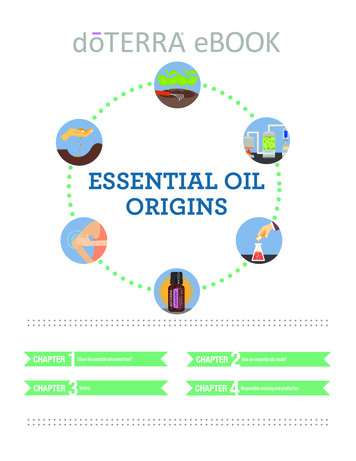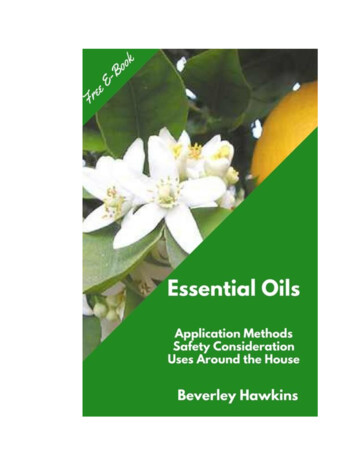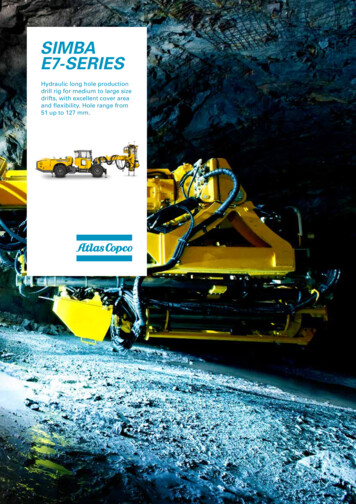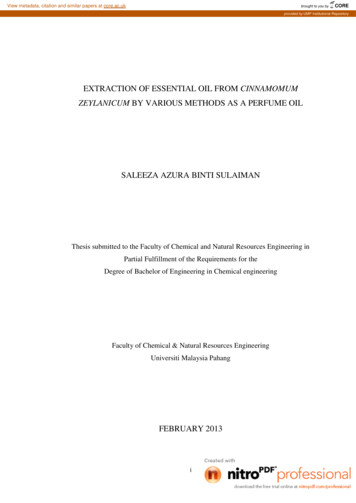
Transcription
11223344CHAPTER112ESSENTIAL OIL23ORIGINS344 1 CHAPTER CHAPTER CHAPTER CHAPTER CHAPTER CHAPTER CHAPTERCHAPTER CHAPTER CHAPTER CHAPTER CHAPTER CHAPTER CHAPTER CHAPTER CHAPTER 1CHAPTER 12CHAPTERCHAPTER 23CHAPTERCHAPTER 34CHAPTER 4CHAPTER 21CHAPTER 2CHAPTER3CHAPTER 3CHAPTER4CHAPTER 4CHAPTERCHAPTER
1234CHAPTER Essential oils are found inplants and plant parts.LEAVESHundreds of thousands of different plants cover the planet earth,playing a vital role in animal and human life by producing oxygen,providing food, regulating water, creating habitats, and more. Thereis a wide variety of plant types, species, and families, and each planthas characteristics that make it useful for certain purposes.CHAPTER Within the seeds, bark, stems, flowers, roots, wood, needles, andfruit of these diverse plants, a variety of essential oils can be found.While the idea of extracting essential oils from plant parts andusing them for things like cooking, health, and aromatherapy mightbe foreign to some, these practices have actually been around forthousands of years. People in several ancient civilizations discoveredhow useful plants and plant parts could be for everyday tasks,and used them for everything from health solutions and beautytreatments to religious ceremonies and burials.CHAPTER While we know much more today about the benefits and uses ofplant parts and essential oils thanks to technology and research,the people of these ancient civilizations had the right idea; there arecountless ways to use plants due to the wide assortment of planttypes and species available. So if you have ever wondered whereessential oils come from, now you know—they are all around us!CHAPTERSTEMFLOWERSFRUIT While not all plants produce essential oils, in plants whereessential oils are found, the oil is typically produced in microscopicspecialized glands on the plant. After the plant produces the oil, it iseither excreted or stored within the glands for future use. The amountof essential oil that a plant produces will vary depending on the timeof day, the current season or time of year, climate and environmental conditions, and predatory threats.1CHAPTER 2CHAPTER ROOTS
What role do essential oilsplay in plant life?Depending on the plant type and structure, essential oils may befound in different parts of a living plant. For example, in some plants,the essential oil can be found within the flowers, while other plantscontain essential oils in the leaves or bark. Regardless of where anessential oil is found within a plant, essential oils are known toplay an important role in plant life because they can performmany functions.In many cases, essential oils give a plant its aroma. In addition togiving a plant a distinct smell, some essential oils have defensiveproperties that protect the plant by keeping insects and herbivoresaway. Essential oils also play an important role in plant pollinationand the reproductive processes of a plant, and can even help aplant heal itself when injured.Keep in mind that not all plants produce essential oils, and not allessential oils found in plant parts will hold meaningful benefits.However, with such a wide range of plants and plant parts to choosefrom, there are still plenty of sources that produce useful essentialoils with significant benefits.Volatile aromatic compoundsFrom a scientific perspective, essential oils are often referred toas volatile aromatic compounds. Volatile aromatic compounds aresmall organic molecules that are known to change quickly from asolid or liquid state to a gas when put at room temperature. Theword “volatile” refers to the quick rate at which these moleculeschange their state. Because essential oils change so quickly from aliquid state to a gas state, they are potent and easy to smell, evenfrom a distance. When you first open an essential oil bottle, you’llbe able to smell the aroma right away. This is because of the volatilenature of essential oils. The physical and chemical makeup ofvolatile aromatic compounds allow them to move quickly through theair and interact with special sensors in the nose. The type of volatilearomatic compounds found in an essential oil will determine whatkind of aroma and benefits the oil has.Today, more than 3,000 types of volatile aromatic compounds havebeen discovered and identified. Essential oils will vary from plantto plant or species to species, and can even differ within botanicalfamilies. Each plant has a special ratio of aromatic constituents thatgive it specific benefits and make it unique in comparisonto other plants.VOLATILE AROMATIC COMPOUNDVOLATILE: A volatile compound is one that changes quicklyfrom one state to another. The organic molecules that make upessential oils are known to change quickly from a liquid to a gaswhen put at room temperature.AROMATIC: Typically, aromatic compounds have a distinct aroma,and a similar chemical structure.COMPOUND: The bonding of two or more chemical elements.How does it work?Now that you understand where essential oils come from, you mightbe wondering, “How does an essential oil get from the inside of aplant to the inside of a bottle?” While it is relatively easy to knowwhere to find essential oils, it requires a delicate, scientific process togrow and care for the plant, extract the oil, and process it properly sothat it can be useful.
1234CHAPTER Extracting essential oils from theirplant parts is a delicate processWhile there are several methods for successfully extracting the essentialoil from a plant and preparing it for use, each method has one thing incommon—it requires extreme caution and care. Because plants are sodelicate, careful planning and precision are necessary to extract highquality essential oils. The process of taking essential oils from their plantparts and preparing them for effective use can be considered as much of anart form as it is a scientific process because of the attention to detail andexactness it requires.CHAPTER Producing quality essential oils also requires a thorough knowledge of theplants being used and proper distillation methods. Most importantly, itrequires substantial care and attention at every single stage of the process,as cutting corners at any phase will result in a lower quality essential oil.CHAPTER Not all essential oils arecreated equal1CHAPTER 2CHAPTER 3CHAPTER 4It is important to note that due to variations in the production process, notall essential oils are created equal. Every element of the production processcan impact the quality of the oil, from planting and growing methods, to how the oil is extracted and distilled, and so on. Some companies mayadd synthetic fillers or take shortcuts during the production process to cutdown on time and save money; however, in the end such practices lower thequality of the oil.CHAPTER When essential oils are produced with extreme care, the naturalbenefitsof the plant are preserved, making the oil more beneficial and useful. Highquality essential oils also provide peace of mind when it comes to using oilsregularly with your family and incorporating them into your daily life. Beforeusing essential oils, it is best to have an understanding of how the oils wereproduced, and if the oil contains any synthetic ingredients or fillers.
Several factors determine the quality of an essential oilAs volatile aromatic compounds, essential oils are very delicate and can easily be altered by several factors. The composition of an essentialoil can be influenced by environmental factors like weather conditions, the amount of rainfall, and temperature.While there are several uncontrollable factors that can influence the quality and composition of an essential oil, many things can be done topreserve the potent aromatic compounds extracted from plant parts. For example, carefully choosing the geographic location and specificclimate for planting, growing, and harvesting plants can influence the quality of the essential oil. Other factors like distillation methods andthe amount of time it takes to extract the essential oil from its plant part can also influence the preservation of the potency and benefits of theessential oil. Because there are so many uncontrollable factors when it comes to growing plants and producing essential oils, it is important toemploy planning and precision when it comes to the controllable factors of this delicate process.Factors that influence essential oil composition geographic location and climate method and duration of distillation harvest time (harvest year, season,and even time of day)PLANTING AND GROWINGProducing a quality essential oil is a detail-oriented process thatstarts with choosing quality land, soil, and seeds. Growers mustconsider these factors as well as the climate of the geographiclocation, the best time of year to plant, and more.For example, the region of Reggio Di Calabria, Italy, has long been asanctuary for growing bergamot fruit due to its unique climate andsoil. In fact, this area is so optimal for growing bergamot, that it isthe only area on earth where the fruit is grown. Because Reggio DiCalabria is close to the ocean, the acidic soil and fresh air from thesea help to strengthen the bergamot trees, which allows them toproduce the best fruit for Bergamot essential oil.Similarly, the bitter orange tree, a tree that produces twigs andleaves used to create Petitgrain oil, has been grown in Paraguay forcenturies because of the country’s abundant rainfall and vast amountof land for growing. Because of the heavy rainfall and room availableto let the bitter orange tree grow wild in the jungle, Paraguay is anideal country for producing leaves and twigs that will eventually beturned into Petitgrain oil. weather conditions, rainfall,temperatures amount of time betweenextraction and distillationRegardless of the geographic location, plant type, or oil beingproduced, it is important that plants are carefully planted, cared for,and closely watched by knowledgeable growers and farmers. Whenthe best methods for planting, growing, and sustaining healthy plantsare used, it contributes to a higher quality essential oil in the end.
HARVESTINGPeak harvestingAfter plants have been carefully planted and maintained, theymust be harvested at the optimal time to help preserve thedelicate chemistry of the essential oils in the plant. Just as fruitsand vegetables taste best when picked at the peak of ripeness,plants used to produce essential oils must be harvested at justthe right time in order to optimize the chemical profile of the oil,and to produce as much oil as possible. Preserving the chemicalcomposition during the harvest process will help the oil retainpotency and power.Peak harvest time will vary depending on the plant. It takes yearsfor harvesters to determine the perfect harvest time for essential oilproduction, and after enough research, harvesters can narrow downthe peak harvest time to the optimal season and even a preferredtime of day.Achieving the optimal chemical profileA plant’s ability or necessity to make an essential oil will depend on the season, and the season in which a plant is harvested for essential oilswill be influenced by precipitation, the presence of insects, the condition of the soil, the amount of sunlight, and more.The chemical profile of an essential oil within a plant is seriously impacted by the particular season and the time of day, as plants go throughseveral stages of blossoming, ripening, and maturation.JASMINE: The flowers of the jasmine plantJUNIPER: Several essential oils can be derivedare used to produce a potent essential oil with alovely aroma. Once the flowers blossom, it doesn’ttake long for them to lose their volatile aromaticcompounds, so it is crucial that they are harvestedat the right time in order to preserve the chemicalprofile. The flowers must be harvested early in themorning before the buds have had time to fullyopen—even waiting an hour too long will causeimportant chemical contents to be lost.from the wood, leaves, and berries of the Juniperusphoenicea tree. Researchers and harvestershave found that Juniper essential oil has a higherpercentage of alpha-pinene (a chemical constituentthat gives the oil specific benefits) during thesummer and autumn months. Not only are thechemical components at the perfect amount duringthis time, but the oil is also higher in antioxidantsduring these months.
Proper harvesting methodsOnce the ideal harvest time has been determined, harvesting plantparts to prepare them for essential oil production is typically a laborintensive process that requires careful technique. Plant parts can beremoved by hand or with the use of tools; however, manual harvestingis usually preferred because it helps the harvester to avoid bruising ordamaging the plant cells that contain essential oils. Removing the plantparts by hand can also allow specific sections containing essential oilsto be removed without damaging the rest of the plant. This helps thenon-harvested part of the plant maintain good health and regrow newparts quickly and effectively so it can be used in the future.SPIKENARD: Spikenard harvesters must travelseveral days through high altitudes to accessthe spikenard plants. Harvesters hike into thehigh mountains of Nepal and spend several daysdigging the spikenard roots out of the ground andcleaning them off. There are only a few months outof the year when spikenard can be harvested, soharvesters must work quickly to get the work donewithin the peak harvest time.For many essential oils, manual labor and removing plant parts byhand is still in practice, but in many cases, technology has allowed formechanical harvesting methods that allow harvesters to gather plantparts quickly, while causing minimal damage to the plant parts.WINTERGREEN: Grown in the mountains ofNepal where it can be “wild harvested,” Wintergreenrequires a labor-intensive process to separate theleaves from the rest of the plant and prepare it fordistillation. Nepalese harvesters must climb steepmountainsides in muddy and rainy conditions toremove the leaves from the wintergreen shrubs. Afterremoving the leaves, harvesters place them in largebaskets, full to the brim, and carry them down themountainside on their backs.Once harvested, plants can be wilted or dried to preserve theirchemical components. The chemical makeup of an essential oilcan vary between the living plant and the harvested plant part. Bybeginning the distillation process as quickly after harvest as possible,the chemical profile will remain as similar to the live plant materialas possible.After proper harvesting, plant parts are transported to a distillerywhere the oil will be extracted. Like the harvest process, thedistillation process is very delicate and must be given extreme careand attention to detail in order to retain the benefits and properties ofthe essential oil.
DISTILLATIONIdentifying the correct plant part for distillationOnce the plant part has been harvested, it is important tostart the distillation process quickly before the plant loses anyof the aromatic compounds or potency. In addition to quicktransportation to the distillery, it is crucial that distillers use thecorrect part of the plant to get the desired essential oil. Becauseessential oils can be found in several areas of a single plant, it isimportant to use the correct plant part when preparing for plantdistillation to ensure the proper aromatic compounds are distilled.For example, the Coriandrum sativum plant produces two kinds ofessential oils: Cilantro and Coriander. Cilantro oil is derived fromthe leaves of the plant, while Coriander oil is taken from the seeds.Cilantro and Coriander oil have a completely different chemicalmakeup, different properties, and varying benefits. For someplants, it will require the distillation of the entire plant to producean essential oil, while other essential oils simply come from asmaller part of the plant, like the leaves, roots, bark, or flowers.Essential OilPlant namePlant part used for essential oilBasilOcimum basilicumLeafBergamotCitrus bergamiaPeelCinnamon BarkCinnamomum iber officinaleRootPeppermintMentha piperitaWhole plantYlang YlangCananga odorataFlower
DISTILLATION METHODSWhile there are several forms of distillation, the main objective of the distillation process is to separate the essential oil from the plantpart to make it a useable oil. The most common types of essential oil extraction are steam distillation and expression. These are organicprocesses that allow aromatic compounds to be gently separated from the rest of the plant, while preserving the potent and delicate chemicalcomponents of the essential oil.CONDENSER(TUBULAR COIL)REMOVABLE LIDSTEAM BOILERCOOLINGWATERSPLANT WATERSteam distillationAs the name suggests, the process of steam distillation uses heatedsteam and pressure to separate essential oils from their plant parts.With this technique, pressurized steam is circulated through theplant material, pulling the oil from the plant part, where it is thencarried away by the steam. Once the steam settles and cools, theoils naturally separate from the water, making it easier to collect theessential oil.1. Steam passes through the plant material.2. Heated steam and light pressure help release theessential oil from the plant’s microscopic protective sacs.3. The vapor mixture flows through a condenser and cools,creating two separate layers of oil and water.4. The essential oil rises to the top and is ready for extraction.Maintaining proper temperaturesBy using pressurization and heat, the intricate chemical profile of anessential oil can be preserved and protected, because the processallows the oil to be distilled well below the normal boiling point.Maintaining the proper temperature throughout the steam distillationprocess is vital, as the incorrect temperature could alter the purityof the essential oil compounds. The optimal steam distillationtemperature is typically between 140 and 212 degrees Fahrenheit,but different plants require various pressure levels, distillationtimes, and temperatures for proper distillation.HAWAIIAN SANDALWOOD: To retrieveessential oil from the santalum paniculatumtree (also known as a Hawaiian Sandalwood),the outer layers of the wood must be strippedaway from the heartwood, or wood in thecenter. The heartwood is then chipped intofine pieces, filtered, and chipped even furtherto create super fine pieces. The wood thenundergoes a 36-hour steam distillationprocess that uses high heat and high pressureto separate the sandalwood oil from the wood.
EXPRESSION OR COLD PRESSINGExpression is another popular distillation method for creating essential oils; however, unlike steam distillation, expression doesn’t use heat toextract the oil from the plant part, but uses precise mechanical pressure to release the oil. Expression is often referred to as “cold pressing”because it doesn’t use heat or steam like other distillation methods.Due to the nature of the expression process, it is typically used to produce citrus essential oils, as cold pressing is useful for extractingessential oils from the rinds and peels of citrus fruits.During the expression process, fruit is placed in the machinery where it is first grated with rough cylinders that cut up the peel’s surface. Asthe peel of the fruit is grated, microscopic sacs of essential oil are released, and water is sprayed over the fruit to collect the essential oil thathas escaped. With the essential oil now mixed with water and pieces from the fruit peel, the oil must be isolated from the other elements. Thisisolation is done through a process of filtering and centrifuge, which separates the pure essential oil from any water or other particles thatcame loose during the grating portion of the ure1. The fruit is placed in theexpression machinery whererough cylinders cut up thepeel’s surface.2. As the peel is grated,microscopic sacs thatcontain essential oilsare released.GRAPEFRUIT: The grapefruit, also known asCitrus X paradisi, was named because the fruit growsin clusters, just as grapes do. Grapefruit essential oilis distilled through the process of expression, and ittakes roughly 50 grapefruit peels to create a 15 mLbottle of Grapefruit essential oil.3. The fruit is sprayed withwater to help collect theessential oil once it hasbeen released.Oil Separatedfrom water bypressure orcentrifugeOil4. The essential oil isfiltered and centrifugedto isolate the oil from anywater or fruit particles.Once an essential oil has been extracted and separated fromits plant part, it must be tested in order to ensure safety andquality. The testing process can help remove any impurities andcontaminants, and prepare the oil for safe, effective use.
234CHAPTER When it comes to producing essential oils, a significant amount of testing must be done to verify that the oil meets a specific set of standards.Truthfully, the testing of essential oils must begin long before a seed is even planted. The essential oil producer must use testing methodsto determine the best plant species to use in production, and to ensure that the proper plant parts are being used. This type of botanicalassessment is important because it will help scientists and chemists know what to look for when it comes time to evaluate the essential oilafter the distillation process.CHAPTER While a significant amount of testing takes place before the planting and growing phase to ensure that certain standards are met, this chapterwill discuss the testing that takes place following the distillation phase of the production process. This portion of the process uses advancedtesting methods to make sure that the essential oil has the correct chemical and physical makeup based on the botanical testing done at thebeginning of the production process.1CHAPTER 2CHAPTER 3CHAPTER 4The importance of testingOnce essential oils have been carefully distilled, they still need to undergo thorough testing to ensure purity and potency before being packaged for final use. Quality testing measures help ensurethat the pure volatile compounds found in essential oils are not only preservedduring the packaging process, but that the compounds appear in the proper amounts for maximum efficacy. There are several tests thatessential oils must undergo to ensure quality; however, the main goals of quality control testing are to verify potency and ensure purity.CHAPTER Verifying potency: helps identify the chemicalcomposition of the oil and determines the potencyand properties of the oil.Ensuring purity: helps ensure that the oil is freeof harmful contaminants or synthetic components. Contaminants and synthetic fillers can alter both thechemical and physical elements of the oil, decreasethe oil’s efficacy, or even have dangerous effects. ADULTERATION: The addition of any synthetic or natural component thatis designed to lower the price of an essential oil, but also lowers the quality andsafety of the oil as it has the potential to alter both the physical and chemicalproperties of the oil, and even cause it to have adverse effects.
Testing and quality assurance will varyfrom company to companyUnlike some products and industries, there is no regulatory bodythat oversees the safety or level of quality when it comes to essentialoils. This means that each company or essential oil producer musttake it upon themselves to verify potency and ensure purity beforepackaging the oils for consumer use.There are several tests that will allow essential oil producers toaccomplish the two main goals of quality control testing—to verifypotency and ensure purity. These tests include, but are not limited to:Microbial testingBecause they come from natural sources, it is important to testessential oils to determine if they contain any bio-hazardousmicroorganisms like bacteria, viruses, fungi, or mold. Microbialtesting analyzes a batch of essential oils by adding a sample fromthe batch to a sterile growth medium in an enclosed dish. Then, thesample is incubated and observed to see if there is any microbialgrowth. Microbial testing is performed as a batch of essential oilsenters the manufacturing facility, and then again on the finishedproduct to ensure that it has not been contaminated at any pointduring the filling or labeling process. Organoleptic testing Microbial testing Gas chromatography Mass spectrometry Fourier TransformInfrared spectroscopy (FTIR) Chirality testing Isotopic analysis Heavy metal testingOrganoleptic testingThe word organoleptic refers to the use of four human senses—sight,smell, taste, and touch. Organoleptic testing requires distillers touse their senses to determine whether an essential oil looks, smells,and feels as it should, or if there is something wrong with the oil.For example, if an oil has an odd smell, unusual color, or unevenconsistency, the distiller will know right away that something is wrongwith the oil. This type of “testing” is typically the first step of qualitycontrol, as experienced and professional distillers, chemists, andtechnicians can typically tell if there is potentially something wrongwith a batch of an essential oil.Gas Chromatography and Mass Spectrometryanalysis (GCMS)The use of gas chromatography and mass spectrometry helpsan essential oil producer analyze the composition and chemicalconstituents in a particular essential oil to make sure that theymatch the expected chemical profile.
Gas chromatographyA gas chromatograph machine vaporizes an essential oil using a carrier gas (like helium), and sends the vapor through a tube that is linedwith chemical components that hold specific properties. Because each essential oil is made up of several different aromatic constituents, theconstituents will interact with the chemical compounds on the walls of the tube in different ways. This will result in each individual constituentmoving through the tube at a different speed. The speed at which each constituent passes through the tube will depend on how muchinteraction the compounds of the oil have with the compounds found on the wall of the tube—the compound will move quickly if it has littleinteraction with the compounds of the tube, and slowly if there is a lot of interaction. At the end of the tube, a detector will record how quickly(or slowly) a compound leaves the tube, and how much of the compound makes it through.Mass spectrometryLike gas chromatography, mass spectrometry helps analyze the composition of an essential oil. This test uses a device called a massspectrometer to identify the different aromatic compounds that are found in a particular oil. After individual compounds have been separatedduring gas chromatography, they are ionized, a process in which a compound is struck by a stream of electrons, causing the neutral moleculeto break apart and become charged. The ions are then sent to magnetic fields where they interact with one another based on their molecularmass and charge. The mass spectrometer reading shows the quantity, mass, and charge of each constituent. This information helps identifythe different aromatic compounds that make up an essential olumnFourier Transform Infrared spectroscopy (FTIR)Another test that can help achieve the goals of ensuring potency and purity in an essential oil is known as Fourier Transform InfraredSpectroscopy, or FTIR. During this test, the structural components the essential oil are examined to determine which compounds are presentin the oil, and thus determine the quality of the oil.An FTIR scan uses infrared light of different frequencies to determine and measure the amount of light that is absorbed by an essential oilsample. When light energy passes through a molecule, the bonds that connect the atoms will move in varying amounts based on the frequencyof the light. The amount of movement in a molecule during the FTIR scan provides a reading that will determine if the essential oil samplecontains desirable structural components. The FTIR reading is compared to other readings from a historical database to determine whetherthe current sample matches the expected absorption profile.
Heavy metal testingChirality testingChirality is a term used to describe the orientation of a molecule.To say that a molecule is chiral means that it has a differentarrangement of bonds between molecules, so different forms wouldbe mirror images of each other rather than identical copies. Amolecule’s orientation will determine how it interacts with othermolecules. If an oil has been altered by adding synthetic fillers, oftenthe types or ratio of chiral molecu
the essential oil can be found within the flowers, while other plants contain essential oils in the leaves or bark. Regardless of where an essential oil is found within a plant, essential oils are known to play an important role in plant life because they can perform many functions. In many cases, essential oils give a plant its aroma.










